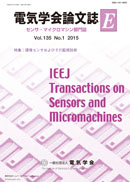Volume 135, Issue 11
Displaying 1-22 of 22 articles from this issue
- |<
- <
- 1
- >
- >|
Special Issue on “Metamaterial and Plasmonics”
Preface
-
2015Volume 135Issue 11 Pages 401
Published: November 01, 2015
Released on J-STAGE: November 01, 2015
Download PDF (539K)
Special Issue Paper
-
2015Volume 135Issue 11 Pages 402-407
Published: November 01, 2015
Released on J-STAGE: November 01, 2015
Download PDF (1456K) -
2015Volume 135Issue 11 Pages 408-413
Published: November 01, 2015
Released on J-STAGE: November 01, 2015
Download PDF (1574K) -
2015Volume 135Issue 11 Pages 414-417
Published: November 01, 2015
Released on J-STAGE: November 01, 2015
Download PDF (1557K) -
2015Volume 135Issue 11 Pages 418-425
Published: November 01, 2015
Released on J-STAGE: November 01, 2015
Download PDF (655K) -
2015Volume 135Issue 11 Pages 426-432
Published: November 01, 2015
Released on J-STAGE: November 01, 2015
Download PDF (2774K) -
2015Volume 135Issue 11 Pages 433-438
Published: November 01, 2015
Released on J-STAGE: November 01, 2015
Download PDF (1785K) -
2015Volume 135Issue 11 Pages 439-444
Published: November 01, 2015
Released on J-STAGE: November 01, 2015
Download PDF (1763K) -
2015Volume 135Issue 11 Pages 445-449
Published: November 01, 2015
Released on J-STAGE: November 01, 2015
Download PDF (991K) -
2015Volume 135Issue 11 Pages 450-453
Published: November 01, 2015
Released on J-STAGE: November 01, 2015
Download PDF (2038K) -
2015Volume 135Issue 11 Pages 454-459
Published: November 01, 2015
Released on J-STAGE: November 01, 2015
Download PDF (1514K) -
2015Volume 135Issue 11 Pages 460-465
Published: November 01, 2015
Released on J-STAGE: November 01, 2015
Download PDF (2636K) -
2015Volume 135Issue 11 Pages 466-473
Published: November 01, 2015
Released on J-STAGE: November 01, 2015
Download PDF (3330K)
Special Issue Letter
-
Fabrication and Characterization of Chain-like Arrangement of Gold Nanoparticles using Nanotemplates2015Volume 135Issue 11 Pages 474-475
Published: November 01, 2015
Released on J-STAGE: November 01, 2015
Download PDF (1005K) -
2015Volume 135Issue 11 Pages 476-477
Published: November 01, 2015
Released on J-STAGE: November 01, 2015
Download PDF (965K) -
2015Volume 135Issue 11 Pages 478-479
Published: November 01, 2015
Released on J-STAGE: November 01, 2015
Download PDF (1267K)
-
2015Volume 135Issue 11 Pages NL11_1
Published: November 01, 2015
Released on J-STAGE: November 01, 2015
Download PDF (865K) -
2015Volume 135Issue 11 Pages NL11_2
Published: November 01, 2015
Released on J-STAGE: November 01, 2015
Download PDF (767K) -
2015Volume 135Issue 11 Pages NL11_3
Published: November 01, 2015
Released on J-STAGE: November 01, 2015
Download PDF (838K) -
2015Volume 135Issue 11 Pages NL11_4
Published: November 01, 2015
Released on J-STAGE: November 01, 2015
Download PDF (1393K) -
2015Volume 135Issue 11 Pages NL11_5-NL11_6
Published: November 01, 2015
Released on J-STAGE: November 01, 2015
Download PDF (640K)
-
2015Volume 135Issue 11 Pages L11_1
Published: November 01, 2015
Released on J-STAGE: November 01, 2015
Download PDF (133K)
- |<
- <
- 1
- >
- >|
